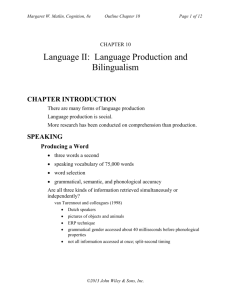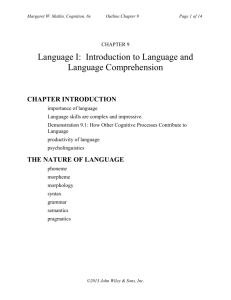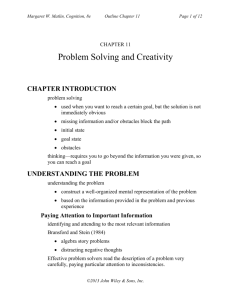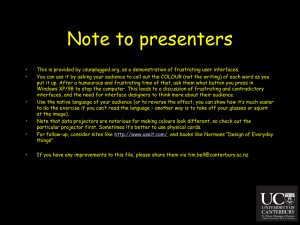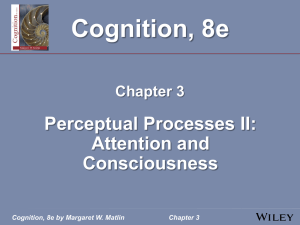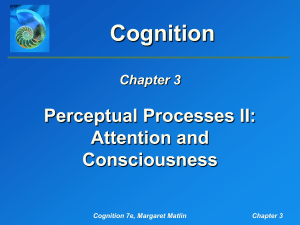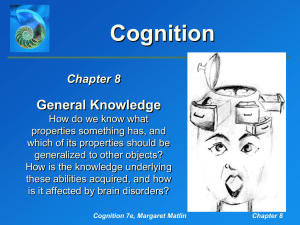Explanations for Attention
advertisement
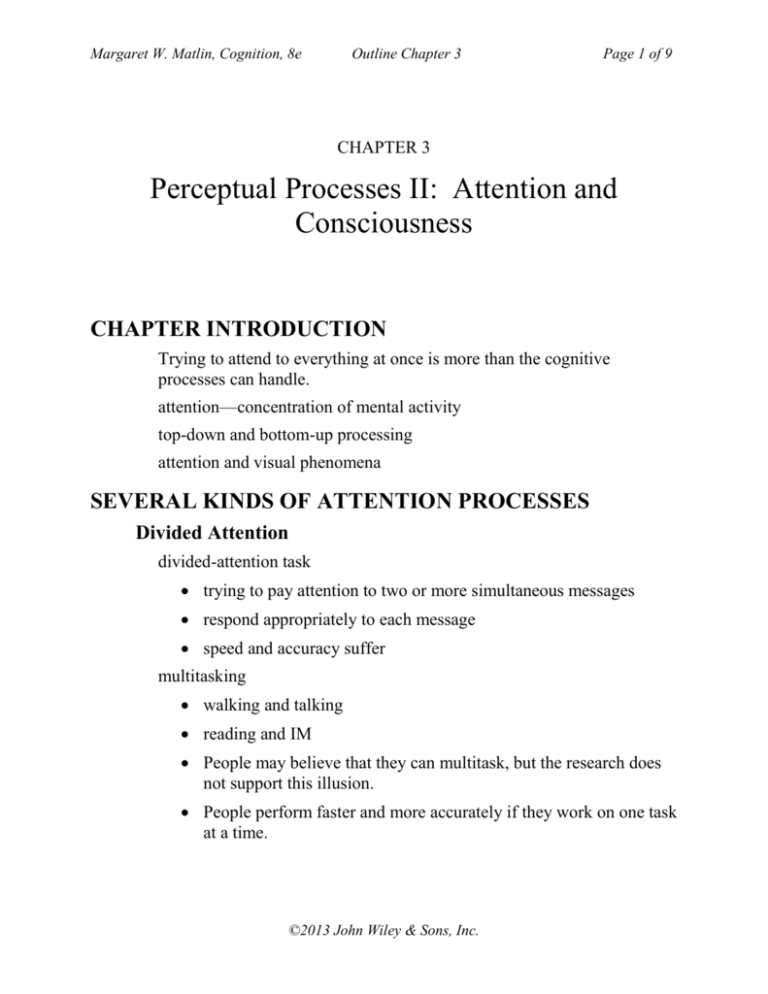
Margaret W. Matlin, Cognition, 8e Outline Chapter 3 Page 1 of 9 CHAPTER 3 Perceptual Processes II: Attention and Consciousness CHAPTER INTRODUCTION Trying to attend to everything at once is more than the cognitive processes can handle. attention—concentration of mental activity top-down and bottom-up processing attention and visual phenomena SEVERAL KINDS OF ATTENTION PROCESSES Divided Attention divided-attention task trying to pay attention to two or more simultaneous messages respond appropriately to each message speed and accuracy suffer multitasking walking and talking reading and IM People may believe that they can multitask, but the research does not support this illusion. People perform faster and more accurately if they work on one task at a time. ©2013 John Wiley & Sons, Inc. Margaret W. Matlin, Cognition, 8e Outline Chapter 3 Page 2 of 9 Divided Attention (continued) driving studies Collet and coauthors (2011) handheld cell phone while driving reaction times during driving are 20% slower than without the cell phone Strayer and colleagues (2003) hands-free cell phones, traffic slower to brake inattentional blindness passenger conversations task switching Selective Attention Overview pay attention to certain kinds of information, while ignoring other ongoing information simplifies our lives People notice little about the irrelevant tasks. Selective attention tasks discussed in Chapter 3: Dichotic listening The Stroop Effect/Task Visual search Saccadic eye movements during reading ©2013 John Wiley & Sons, Inc. Margaret W. Matlin, Cognition, 8e Outline Chapter 3 Page 3 of 9 Dichotic Listening a selective-attention task one message presented to left ear and a different message presented to right ear shadow one of the messages People notice very little about the unattended message. In general, people can process only one message at a time. However, people may process the unattended message when: 1. both messages are presented slowly 2. the task is not challenging 3. the meaning of the unattended message is immediately relevant cocktail party effect working memory capacity The Stroop Effect a selective-attention task Demonstration 3.1: The Stroop Effect naming the ink color of words incongruent words vs. colored patches People take a long time to name the ink color when that color is used in printing an incongruent word; in contrast, they can quickly name that same ink color when it appears as a solid patch of color. explanations in terms of PDP and practice reading as automatic process emotional Stroop task naming the ink color of words with strong emotional significance trouble ignoring emotional reactions phobic disorder—slower on anxiety-arousing words than on control words ©2013 John Wiley & Sons, Inc. Margaret W. Matlin, Cognition, 8e Outline Chapter 3 Page 4 of 9 The Stroop Effect (continued) attentional bias suicide depression addiction eating disorders Individual Differences: Eating Disorders and the Stroop Effect Pringle and coauthors (2010) online questionnaire, female dieters emotionally relevant words related to body shape, weight, eating; neutral words Stroop task; Eating Attitudes Test When women took much longer to read words related to shape (as opposed to the control words), they were especially likely to have high scores on the Eating Attitudes Test (risk for developing eating disorders. cognitive-behavioral approach Visual Search a selective-attention task find a target in a visual display with numerous distractors Variables Influencing Visual Search more accurate if the target appears frequently Treisman studies 1. The isolated-feature/combined-feature effect. Demonstration 3.2: Treisman and Gelade (1980) searching for blue Xs If the target differed from the irrelevant items in the display with respect to a simple feature such as color, observers could quickly detect the target. When the irrelevant items force you to search for a combination of features (both blue and X), visual search takes longer. 2. The feature-present/feature-absent effect. Demonstration 3.3: Treisman and Souther (1985) searching for "circle with the line" or "circle without the line" People can typically locate a feature that is present more quickly than a feature that is absent. ©2013 John Wiley & Sons, Inc. Margaret W. Matlin, Cognition, 8e Outline Chapter 3 Page 5 of 9 Visual Search (continued) Royden and colleagues (2001) People can quickly locate one moving target when it appears in a group of stationary distractors. In contrast, they take much longer to locate one stationary target when it appears in a group of moving distractors. It’s easier to spot a movement-present object than a movement-absent object. In Depth: Saccadic Eye Movements During Reading a selective-attention task eye movements important in looking, searching, driving, speaking, and reading saccadic eye movement series of little jumps of the eye bring the center of the retina (fovea) over the words being read fixation perceptual span patterns—The eye usually moves past blank spaces, short words, and highly predictable words, but the eye usually pauses for misspellings, unusual words. good readers vs. poor readers—size of saccadic movements, regressions, pauses ©2013 John Wiley & Sons, Inc. Margaret W. Matlin, Cognition, 8e Outline Chapter 3 Page 6 of 9 EXPLANATIONS FOR ATTENTION Neuroscience Research on Attention Compare Figure 3.2: Brain Regions Important on Attention Tasks and Figure 2.1: Brain Regions Important in Object Recognition The Orienting Attention Network selecting information from sensory input visual search parietal lobe brain lesions unilateral neglect PET scans indicate increased blood flow in the parietal cortex when people perform visual searches and when they pay attention to spatial locations. develops during first year of life The Executive Attention Network used when task features conflict Stroop task inhibiting automatic responses to stimuli prefrontal cortex top-down control of attention develops about age 3 academic skills (e.g., reading) meditation learning new ideas ©2013 John Wiley & Sons, Inc. Margaret W. Matlin, Cognition, 8e Outline Chapter 3 Page 7 of 9 Theories of Attention Early Theories of Attention Bottleneck theories narrow passageway information either passes through bottleneck or is lost too simple; underestimates flexibility information not lost at just one phase of the attention process Feature-Integration Theory (Anne Treisman) 1. The basic elements distributed attention register features automatically parallel processing identify features simultaneously low-level processing focused attention slower serial processing identify one object at a time complex objects identify which features belong together 2. Research on the theory isolated features (distributed attention) combined features (focused attention) Demonstration 3.2A vs. Demonstration 3.2B Distributed attention can operate in a parallel fashion and relatively automatically; the target seemed to ‘‘pop out’’ in Demonstration 3.2A. People need more time to find the target when there are a large number of distractors in a focused-attention task. illusory conjunction inappropriate combination of features occurs when attention is overloaded or distracted features processed independently binding problem illusory conjunctions with printed verbal material role of top-down processing ©2013 John Wiley & Sons, Inc. Margaret W. Matlin, Cognition, 8e Outline Chapter 3 Page 8 of 9 Feature-Integration Theory (Anne Treisman) (continued) 3. Current status of the theory Distributed attention can occasionally resemble focused attention. Visual system may use distributed attention to quickly gather information about the general gist of a scene. CONSCIOUSNESS consciousness—the awareness people have about the outside world and about their perceptions, images, thoughts, memories, and feelings related to attention, but not identical generally associated with controlled, focused attention that is not automatic Three Interrelated Issues 1. our inability to bring certain thoughts into consciousness 2. our inability to let certain thoughts escape from consciousness 3. blindsight Consciousness of our higher mental processes mindless reading mind wandering Nisbett & Wilson (1977) little direct access to our thought processes products vs. processes People have relatively complete access to some thought processes, but only limited access to other thought processes. ©2013 John Wiley & Sons, Inc. Margaret W. Matlin, Cognition, 8e Outline Chapter 3 Page 9 of 9 Thought Suppression thought suppression—the attempt to eliminate thoughts, ideas, and images related to an undesirable stimulus Demonstration 3.5: Do not think about a white bear! ironic effects of mental control Wegner Tolstoy's "white bear" task initial suppression of specific thoughts can produce a rebound effect Similar effect found for: pain suppression concentration avoiding movement trying to fall asleep Clinical applications avoiding depressing topics post-traumatic stress disorder generalized anxiety disorder obsessive-compulsive disorder Blindsight vision without awareness damage to visual cortex can still identify some visual attributes of stimulus reported as "not seen" (no conscious awareness of object) Possible explanations A small portion of the information from the retina travels to other locations on the cerebral cortex, outside the visual cortex Some characteristics of the visual stimulus may be identified by information registered in other cortical locations. Primary visual cortex is necessary for conscious awareness of visual information. Perception of the stimulus (without conscious awareness) may be possible. Research on consciousness demonstrates that "how things seem" is not necessarily "how things are." ©2013 John Wiley & Sons, Inc.
